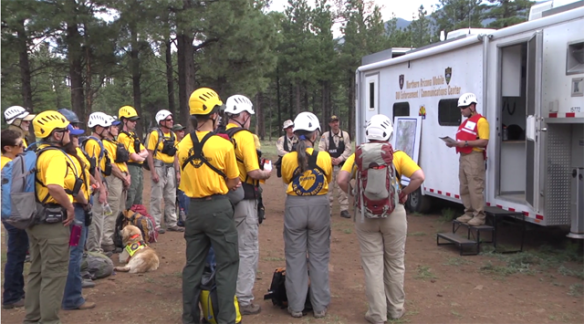 TUSYAN — The Mason Fire on the Tusayan Ranger District of the Kaibab National Forest has been contained after growing to 4,370 acres and providing multiple resource benefits since it started a few weeks ago.
TUSYAN — The Mason Fire on the Tusayan Ranger District of the Kaibab National Forest has been contained after growing to 4,370 acres and providing multiple resource benefits since it started a few weeks ago.
The Mason Fire, located 7 miles southeast of Tusayan and 4 miles south of Grandview Lookout Tower, was one of four lightning-caused wildfires being managed as part of the Jar Complex to achieve ecological and other resource and community protection objectives. The Old Fire eventually merged with the larger Mason Fire, while the Lost and Shale fires that were located just east of Highway 64 several miles south of Tusayan never grew larger than about an acre in size each due to persistent rain showers over their locations.
“The Lost and Shale fires were in an ideal location, and we hoped they would eventually pick up in activity so that fire could move across the landscape,” said Quentin Johnson, fire management officer for the Tusayan Ranger District and incident commander for the Jar Complex. “But it was the Mason Fire that ended up having the most growth potential, and we are pleased that it reached the size it did.”
The Mason Fire burned at low-to-moderate levels of intensity over the course of its existence and had effects fire managers said were important in enhancing wildlife habitat, reducing the potential for future high-intensity fires, and improving forest health conditions.
As noted by Bruce Hill, fire lookout at Red Butte and a valued member of the Tusayan Ranger District fire organization, the Mason Fire not only met resource objectives but did so without impacting visibility at Grand Canyon National Park, an accomplishment that is not always easy to achieve given the district’s location just south of the iconic canyon.
While smoke was visible at times from Desert View, Cameron, Tusayan and highways 64 and 180, impacts were short-lived and mostly isolated to light smoke sinking into low-lying areas south of Tusayan along Highway 64 in the early morning hours on a few days.
Johnson added that he was proud that fire was able to play its natural role as a disturbance factor in the ecosystem and, that during its 22 days of spread, there were no injuries to fire fighters involved in its management.
The Mason and Old fires were both managed within a predefined 16,100-acre planning area. However, as the fires merged and then spread into sparser fuels, they naturally started dying out on their own. Then, significant precipitation associated with Hurricane Delores reached the Mason Fire over the weekend, putting it out almost entirely.
“For us, a planning area represents where we would be comfortable with and think the fire could eventually spread given the right conditions,” said Johnson. “It doesn’t mean it’s always going to get there, and that’s okay. We are allowing the fire to do what it would have naturally done historically. It would have been started by lightning during monsoon season, moved around for days or weeks, and then been put out by rain or by reaching natural landscape features. That’s exactly what happened with the Mason Fire. To me, that’s a success story.”
Like this:
Like Loading...


 Mendocino County, CALIFORNIA — Bowe Bergdahl, the U.S. Army deserter who was traded for four terrorists, was “detained” in Mendocino County, California at a marijuana raid while on leave.
Mendocino County, CALIFORNIA — Bowe Bergdahl, the U.S. Army deserter who was traded for four terrorists, was “detained” in Mendocino County, California at a marijuana raid while on leave.
 TUSYAN — The Mason Fire on the Tusayan Ranger District of the Kaibab National Forest has been contained after growing to 4,370 acres and providing multiple resource benefits since it started a few weeks ago.
TUSYAN — The Mason Fire on the Tusayan Ranger District of the Kaibab National Forest has been contained after growing to 4,370 acres and providing multiple resource benefits since it started a few weeks ago.
 by Anthony Gucciardi
by Anthony Gucciardi
 FLAGSTAFF — A new training video which was a year in the making titled “Introduction to Search Management Best Practices” has been released to aid in training search managers. The video project was a joint effort between the Coconino County Sheriff’s Office Search and Rescue Unit, a Mountain Rescue Association member team, and the National Park Service Branch of Search and Rescue. To maximize its benefit to the search and rescue community, the video is being distributed free of charge via the internet. The video is intended to be used in conjunction with a comprehensive search management course or as a review of search management concepts for seasoned search managers.
FLAGSTAFF — A new training video which was a year in the making titled “Introduction to Search Management Best Practices” has been released to aid in training search managers. The video project was a joint effort between the Coconino County Sheriff’s Office Search and Rescue Unit, a Mountain Rescue Association member team, and the National Park Service Branch of Search and Rescue. To maximize its benefit to the search and rescue community, the video is being distributed free of charge via the internet. The video is intended to be used in conjunction with a comprehensive search management course or as a review of search management concepts for seasoned search managers.